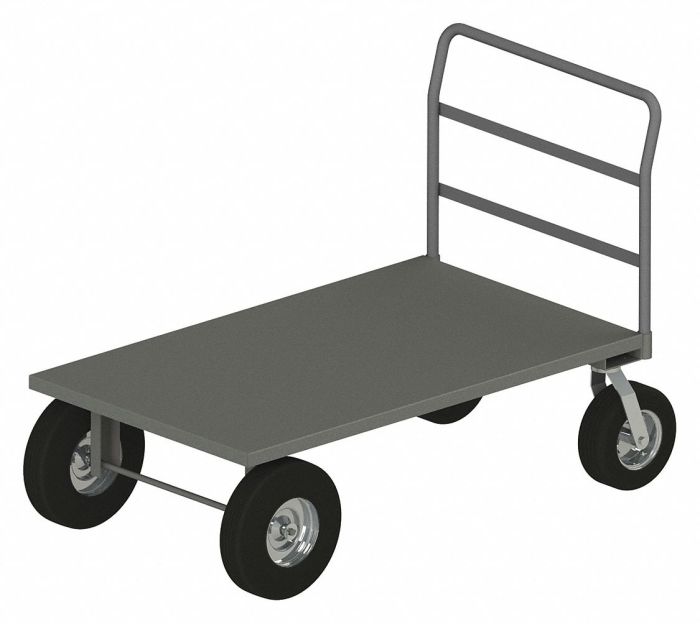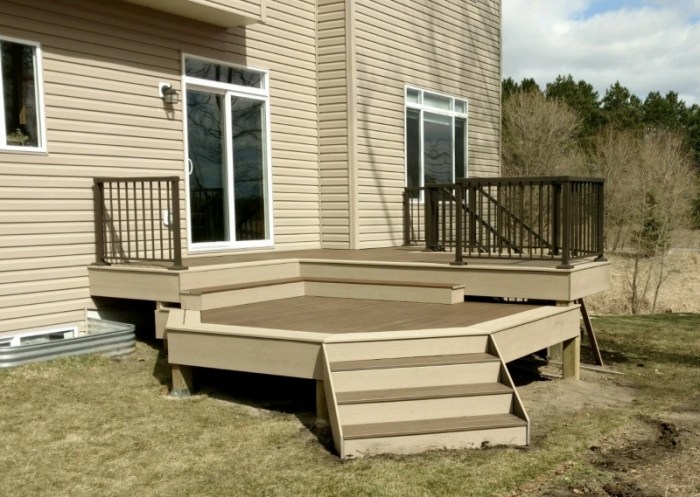Steel Deck Platform Truck A Comprehensive Guide
Steel deck platform trucks are essential in various industries, providing a safe and versatile platform for a wide range of tasks. This guide delves into their design, construction, applications, maintenance, safety, economic considerations, and future trends. From basic descriptions to advanced features, it explores everything about steel deck platform trucks.
This detailed overview explores the different types of steel deck platform trucks, from single-axle to tandem-axle models, and examines their specific applications in construction, maintenance, and logistics. It highlights the importance of safety features, the various steel types used, and the maintenance procedures to ensure longevity and optimal performance. The economic implications and future advancements in steel deck platform truck technology are also discussed, making this a complete resource for anyone working with or interested in these crucial vehicles.
Overview of Steel Deck Platform Trucks
Steel deck platform trucks are versatile and essential pieces of equipment in various industries, providing a robust and reliable platform for transporting materials and equipment. They offer a straightforward solution for moving heavy or bulky goods, and their adaptability allows them to be used in diverse scenarios. Their construction often prioritizes strength and durability, making them capable of withstanding the rigors of heavy-duty operations.
These trucks are highly adaptable and are often customized to meet specific needs, showcasing a wide range of configurations. This adaptability, combined with their inherent strength, makes them a popular choice for various sectors, from construction to manufacturing.
Key Features and Characteristics
Steel deck platform trucks are characterized by their robust steel decks, which provide a stable and secure platform for loading and unloading. The decks are typically reinforced to withstand heavy loads and are often designed for specific types of cargo. The trucks themselves are built to be durable and resilient, with heavy-duty axles and suspension systems to manage weight and maintain stability during transit. Safety features, such as guardrails and handholds, are frequently incorporated to ensure worker safety.
Types of Steel Deck Platform Trucks
Different types of steel deck platform trucks cater to diverse load capacities and applications. These variations are crucial in selecting the right truck for a particular job. The configuration of axles, deck dimensions, and overall structure play a critical role in the truck’s ability to handle the specific load and conditions.
Load Capacity and Dimensions
| Type | Load Capacity (approximate) | Dimensions (approximate) | Typical Applications |
|---|---|---|---|
| Single-Axle | Up to 10,000 lbs | Varying lengths and widths | Moving smaller loads, short distances, and light-duty operations |
| Tandem-Axle | 10,000 lbs to 25,000 lbs+ | Varying lengths and widths | Moving heavier loads, longer distances, and construction sites |
| Triple-Axle | 25,000 lbs and above | Varying lengths and widths | Moving extremely heavy loads, longer distances, heavy construction, or material handling |
This table provides a general comparison of different axle configurations, highlighting the varying load capacities and typical applications. Specific models and manufacturers will have varying load capacities and dimensions, so always refer to the manufacturer’s specifications for precise details.
Industries Using Steel Deck Platform Trucks
Steel deck platform trucks are used across a broad spectrum of industries. Their versatility makes them valuable assets in diverse sectors.
- Construction: Steel deck platform trucks are essential for transporting building materials, equipment, and personnel on construction sites. Their ability to carry heavy loads and their stability make them critical for various construction tasks.
- Manufacturing: In manufacturing, these trucks are used for transporting raw materials, finished goods, and machinery. Their adaptability allows them to fit specific layouts and needs within factories and warehouses.
- Warehousing: Warehouses utilize steel deck platform trucks for the movement of goods within their facilities, enhancing efficiency and streamlining workflows. Their ability to navigate various warehouse layouts is key to optimal operations.
- Utility Companies: Utility companies employ these trucks for transporting equipment and materials to various job sites, aiding in infrastructure maintenance and repairs.
These are just a few examples, and the use cases for steel deck platform trucks are constantly evolving as industries find new and innovative ways to use them.
Design and Construction
Steel deck platform trucks are vital components in various industries, from construction to logistics. Their robust design and careful construction are paramount to ensuring safety and longevity. The careful selection of materials and the implementation of advanced safety features directly impact the performance and reliability of these trucks.
The fabrication of steel deck platform trucks involves a meticulous process that prioritizes structural integrity and durability. This process encompasses the choice of materials, the precision of welding techniques, and the incorporation of reinforcing elements. The design must accommodate the expected load capacity and operational environment, guaranteeing the truck’s ability to withstand rigorous use without compromising safety.
Materials and Construction Methods
The construction of steel deck platform trucks heavily relies on high-strength steel alloys. These alloys, carefully selected for their tensile strength and yield strength, are crucial for withstanding the substantial loads they are designed to carry. Commonly used steels include structural steel grades like ASTM A36 and higher-strength grades such as A572, each having varying degrees of strength and weldability. The choice of steel directly impacts the truck’s durability and the ability to withstand repeated stress. Different welding techniques are also employed, such as shielded metal arc welding (SMAW) and flux-cored arc welding (FCAW), which ensure the quality and integrity of the welded joints.
Structural Integrity and Safety Features
Ensuring structural integrity is paramount in steel deck platform trucks. Proper design considerations, including load calculations, material selection, and reinforcement strategies, are essential to prevent failure. Safety features are integral to the design process, mitigating risks associated with potential accidents. Robustly designed railings, guardrails, and handrails are standard features.
Types of Steel and Their Impact
The choice of steel grade significantly influences the performance and durability of the platform truck. ASTM A36 steel, while widely used due to its affordability, possesses a lower yield strength compared to higher-grade steels. Higher-grade steels, such as A572, offer enhanced strength and durability, allowing for greater load capacity and resilience against damage. The selection of steel must carefully balance cost-effectiveness with the required load-bearing capacity. This careful selection often involves consulting engineering specifications and conducting rigorous stress tests to determine the most suitable steel grade.
Safety Features
A robust safety system is crucial for steel deck platform trucks. The following table illustrates some key safety features and their benefits:
| Feature Name | Description | Safety Benefit |
|---|---|---|
| Guardrails | Steel barriers along the edges of the platform | Prevent falls and protect personnel from hazards. |
| Handrails | Steel handholds on the platform | Provide a secure grip for personnel during operation. |
| Toeboards | Metal strips along the edges of the platform | Prevent tools or materials from falling off the platform. |
| Welded seams | Strong welds ensure structural integrity | Prevent the separation and collapse of the platform. |
| Load capacity plates | Plates indicating the maximum load capacity. | Prevent overloading, a primary cause of accidents. |
Reinforcements for Structural Integrity
Reinforcements play a vital role in enhancing the structural integrity and damage resistance of steel deck platform trucks. Different reinforcement types are employed to address specific stress points and prevent deformation under load. These include:
- Reinforcing plates: These are strategically placed plates to increase the load-bearing capacity of the deck in areas prone to stress concentrations.
- Ribs and stiffeners: These structural members, running along the platform, enhance rigidity and prevent buckling under load.
- Corner reinforcements: These reinforcement elements strengthen the corners of the platform, ensuring durability against bending and torsion.
These reinforcements ensure the platform can withstand the stresses imposed by various loading conditions. Properly designed and installed reinforcement is essential to prevent potential structural failures.
Applications and Uses
Steel deck platform trucks find extensive use across diverse industries, their versatility stemming from their robust construction and adaptable design. These trucks excel in various logistical and operational settings, proving invaluable for transporting materials and personnel in demanding environments. Understanding the specific application requirements is crucial for selecting the optimal truck configuration.
The applications of steel deck platform trucks extend beyond a single industry. Their load-bearing capacity, stability, and maneuverability are key factors that make them a suitable choice for a wide range of tasks. From construction sites to industrial facilities and logistics operations, these trucks are critical for efficient material handling and personnel transport.
Diverse Applications in Various Industries
Steel deck platform trucks are employed in a multitude of industries due to their adaptability. Their ability to handle varying loads and navigate different terrains makes them a reliable workhorse.
- Construction: Steel deck platform trucks are fundamental in construction projects. They facilitate the transport of heavy equipment, building materials, and personnel to different parts of the site, ensuring smooth operations. They are particularly useful for reaching elevated areas and navigating complex terrain, which is common in construction projects.
- Maintenance: These trucks are also frequently used in maintenance operations. They allow for the safe and efficient transport of equipment and personnel to various locations for repair and maintenance work, including utility poles, bridges, and pipelines. Their stability and load capacity are crucial for these tasks.
- Logistics: In logistics, steel deck platform trucks are used for transporting various goods, including oversized or bulky items. Their spacious platform allows for efficient loading and unloading, optimizing workflow and delivery times.
Specific Requirements for Different Applications
Selecting the appropriate steel deck platform truck depends on specific requirements. Load capacity, stability, and maneuverability are crucial considerations. The desired carrying capacity, the terrain to be navigated, and the size of the cargo all play a significant role.
- Load Capacity: The truck’s load capacity must be sufficient to handle the weight of the materials and personnel being transported. Overloading can compromise the truck’s stability and safety.
- Stability: The truck’s design and construction should ensure stability, especially when transporting heavy loads or operating on uneven terrain. Features like wide tracks and reinforced frames contribute to overall stability.
- Maneuverability: Maneuverability is crucial, especially in confined spaces. Features such as maneuverable steering and compact design facilitate easy movement within tight spaces and around obstacles.
Comparison with Other Platform Trucks
Steel deck platform trucks offer advantages and disadvantages compared to other materials, such as aluminum. The choice of material impacts cost, weight, and durability.
| Material | Advantages | Disadvantages |
|---|---|---|
| Steel | High load capacity, robust construction, and cost-effectiveness in many applications | Heavier weight, susceptibility to corrosion if not properly maintained |
| Aluminum | Lighter weight, better corrosion resistance | Lower load capacity compared to steel, potentially higher initial cost |
| Other Materials (e.g., composite materials) | Specific advantages in certain aspects, such as lightweight and enhanced strength-to-weight ratio | Often higher cost and less readily available compared to steel or aluminum |
Factors Influencing the Choice of Truck
Several factors influence the selection of a particular steel deck platform truck. A thorough evaluation of these elements ensures the chosen truck meets specific needs.
- Budget: The initial cost and maintenance costs are critical considerations. The cost of steel and its associated manufacturing processes influence the price of the final product.
- Load Capacity Requirements: Determining the maximum weight to be transported is paramount. Exceeding the load capacity is extremely dangerous.
- Operating Environment: The terrain, climate, and environmental conditions significantly influence the truck’s performance. The need for enhanced protection from weather or specific terrain types can affect the truck’s design.
Maintenance and Repair
Proper maintenance and repair are crucial for the longevity and safe operation of steel deck platform trucks. Neglecting these aspects can lead to costly repairs, safety hazards, and reduced operational efficiency. A well-maintained truck will ensure consistent performance, minimize downtime, and extend the life of the vehicle.
Regular maintenance is key to preventing potential issues and ensuring the truck remains in optimal working condition. This includes not only routine checks but also proactive measures to address potential problems before they escalate. The consistent application of preventative maintenance is a critical aspect of ensuring the vehicle’s safety and operational reliability.
Routine Maintenance Procedures
Regular checks and preventative maintenance are vital to maintain the structural integrity, functionality, and safety of the steel deck platform truck. This involves examining critical components and addressing any identified issues promptly. Failure to perform these procedures can result in more extensive and expensive repairs down the line.
- Chassis Inspection: Examine the chassis for signs of rust, damage, or deformation. Look for cracks, dents, or loose bolts. Inspect the suspension components for wear and tear, ensuring they meet the manufacturer’s specifications. Check for proper lubrication of moving parts.
- Deck Inspection: Assess the deck for any damage, such as cracks, holes, or signs of overloading. Ensure the deck’s surface is clean and free of debris. Verify the integrity of any safety features, such as handrails and guardrails.
- Safety Feature Inspection: Thoroughly inspect all safety features, including handrails, guardrails, and any safety harnesses. Ensure they are securely fastened and free from any damage. Inspect emergency stop mechanisms and check their functionality. Regularly inspect and test emergency lights and warning devices.
- Braking System Inspection: Inspect the brake lines, pads, and drums for wear and tear. Check the brake fluid levels and ensure they are within the recommended range. Test the braking system’s responsiveness and effectiveness to ensure safe stopping.
- Electrical System Inspection: Inspect the wiring harness for damage or corrosion. Ensure all electrical components are functioning correctly. Test lights, indicators, and other electrical systems. Check battery condition and terminals.
Maintenance Schedule
A well-defined maintenance schedule is critical for proactive maintenance and minimizing unexpected downtime. This schedule should be tailored to the specific operating conditions and usage patterns of the truck.
| Task | Frequency | Necessary Tools |
|---|---|---|
| Chassis Inspection | Weekly | Visual inspection, lubrication tools |
| Deck Inspection | Weekly | Visual inspection, measuring tools (for cracks) |
| Safety Feature Inspection | Monthly | Visual inspection, torque wrench (if needed) |
| Braking System Inspection | Monthly | Brake fluid tester, torque wrench |
| Electrical System Inspection | Quarterly | Multimeter, wiring repair kit |
| Lubrication | As Needed | Lubricants, grease guns, and oil filters |
Repair Procedures
Addressing issues promptly is vital to avoid escalating problems. Repair procedures should adhere to the manufacturer’s recommendations and safety guidelines.
- Deck Repair: Minor cracks in the deck can often be repaired with epoxy or fiberglass patching. More extensive damage may require replacing sections of the deck. Professional assessment and repair are recommended for severe damage.
- Chassis Repair: Rust repair involves removing the rust, applying a suitable primer, and repainting the affected area. Welding might be required for structural damage. Professional repair is crucial for structural integrity issues.
- Braking System Repair: Brake pad replacement involves removing the old pads and installing new ones. Brake line repairs require careful handling and specialized tools. Fluid leaks need to be addressed by locating and fixing the source. Always consult the manufacturer’s guidelines.
Safety and Compliance: Steel Deck Platform Truck

Source: grainger.com
Steel deck platform trucks, while valuable tools, necessitate rigorous adherence to safety regulations. Proper operation and maintenance are paramount to mitigating risks and ensuring the well-being of operators and bystanders. This section details the crucial safety aspects and compliance requirements for these trucks.
Ensuring the safety of workers and the public is paramount in the operation of steel deck platform trucks. Adherence to established safety protocols and regulations is essential to prevent accidents and injuries. This includes strict adherence to industry standards and legal requirements, along with the use of appropriate safety equipment. Failure to comply can lead to serious consequences, including fines, legal action, and potential injuries.
Safety Regulations and Standards
Numerous regulations and standards govern the design, construction, and operation of steel deck platform trucks. These regulations aim to protect workers and the public from potential hazards. Compliance is vital for both legal and ethical reasons.
Importance of Adhering to Safety Protocols
Adherence to safety protocols is crucial for minimizing risks associated with steel deck platform truck operation. It includes proper training for operators, regular inspections, and adherence to load limits. This proactive approach significantly reduces the likelihood of accidents and ensures the safety of all individuals involved. Failing to adhere to protocols can result in serious consequences, including injuries, property damage, and legal repercussions.
Required Safety Equipment
A comprehensive list of safety equipment is essential for the safe operation of steel deck platform trucks. This includes, but is not limited to, safety harnesses, fall protection systems, appropriate footwear, and eye protection. The specific equipment required may vary based on the application and the particular hazards present.
Safety Regulations Table
| Regulation Category | Industry Standard | Legal Requirement |
|---|---|---|
| Load Capacity | ANSI B30.20 | Local and national building codes |
| Fall Protection | OSHA 1926 Subpart M | Local and national safety regulations |
| Operator Training | Specific industry training programs | Licensing and certification requirements |
| Inspection and Maintenance | Manufacturer’s recommendations | Regular safety inspections |
Note: This table provides a general overview. Specific requirements may vary depending on local and national regulations. Always consult with local authorities and relevant industry standards for the most up-to-date information.
Hazard Prevention and Mitigation Procedures
Proactive measures are crucial in preventing potential hazards. This includes thorough pre-operational inspections, careful loading procedures, and adherence to maximum load limits. Regular safety meetings and operator training can help maintain awareness of potential risks. Potential hazards should be assessed and risk mitigation strategies implemented.
- Pre-operational inspections are critical for identifying and addressing any potential issues with the truck’s structural integrity, safety equipment, and operating mechanisms. A thorough checklist should be used for this purpose. Proper documentation of these inspections is essential.
- Proper loading procedures, including verifying the weight distribution and load capacity, are vital to avoid overloading and ensure stability. Consult the manufacturer’s guidelines and relevant regulations for specific loading requirements.
- Strict adherence to maximum load limits is paramount to prevent accidents. Operators should be trained to recognize and avoid exceeding the weight limits specified for the truck.
Economic Considerations
Steel deck platform trucks, while offering substantial utility, demand careful consideration of their economic implications. Understanding the total cost of ownership, comparing it to alternatives, and recognizing long-term financial benefits is crucial for informed decision-making. Proper maintenance and efficient operation play a significant role in minimizing costs and maximizing return on investment.
The financial picture for a steel deck platform truck extends beyond the initial purchase price. Operating expenses, maintenance needs, and potential downtime all contribute to the overall cost of ownership. This comprehensive analysis explores these factors, helping potential users to weigh the economics of this vital piece of equipment.
Purchase Costs
Initial investment for a steel deck platform truck varies widely based on factors like size, features, and manufacturer. A smaller, entry-level model might cost less than $50,000, while larger, more specialized models can exceed $150,000. Options like hydraulic lifts, specialized attachments, and enhanced safety features can significantly impact the initial price tag. Financing options, including loans and leasing, are available to manage the financial burden of the initial purchase.
Maintenance Costs
Regular maintenance is essential for minimizing long-term costs and preventing costly repairs. Routine checks, such as lubrication, inspection of hydraulic components (if applicable), and tire rotations, can prevent major issues. The cost of these preventive measures is significantly lower than the expenses associated with breakdowns or major repairs. Detailed maintenance schedules, ideally created with input from a qualified technician, can provide a roadmap for cost-effective maintenance.
Operating Costs
Fuel consumption, labor costs, and potential downtime directly affect operating expenses. The fuel efficiency of the truck, the driving habits of the operator, and the frequency of trips all contribute to fuel expenditure. Optimal loading and unloading procedures can minimize wear and tear, extending the life of the truck and reducing repair costs. Proper training of operators can improve efficiency and minimize downtime due to errors or accidents.
Cost Comparison with Alternatives
The cost-effectiveness of a steel deck platform truck must be weighed against alternative solutions. For smaller, infrequent jobs, renting specialized equipment might be more economical. However, for frequent use or demanding applications, the long-term cost savings of owning a well-maintained truck often outweigh the initial investment. Considering factors like project volume, duration, and the need for specialized features will help in making an informed decision.
Long-Term Financial Benefits
Investing in a well-maintained steel deck platform truck offers long-term financial benefits. Reduced downtime translates to higher productivity and faster project completion. A properly maintained truck has a longer lifespan, minimizing the need for frequent replacements. By prioritizing preventative maintenance, businesses can realize substantial cost savings over the lifespan of the equipment.
Cost Savings Through Proper Maintenance and Operation
“A proactive maintenance strategy is crucial for reducing unexpected repair costs.”
Implementing a comprehensive maintenance schedule can help avoid costly repairs. For instance, regular lubrication prevents wear and tear on moving parts, while timely tire rotations maintain optimal performance and extend tire life. Efficient loading and unloading techniques, coupled with adherence to safety protocols, significantly reduce the risk of accidents and associated repair costs. Examples include a company that reduced maintenance costs by 25% after implementing a detailed preventive maintenance program. Another company reported reduced downtime by 15% after optimizing loading and unloading procedures.
Future Trends and Innovations
Steel deck platform trucks are constantly evolving to meet the demands of modern logistics and construction. This evolution is driven by a combination of factors, including advancements in materials science, increasing safety concerns, and the need for greater efficiency. The future of these trucks promises significant innovations that will impact their design, construction, and operation.
Emerging Trends in Design and Development
The design and development of steel deck platform trucks are witnessing several significant trends. These trends are focused on improving performance, enhancing safety, and reducing operating costs. The incorporation of lightweight materials and advanced construction techniques is becoming increasingly prevalent. This approach aims to optimize the truck’s payload capacity and overall efficiency.
Advancements in Materials
The use of advanced materials, such as high-strength steel alloys and composite materials, is expected to continue. These materials offer enhanced strength-to-weight ratios, potentially leading to lighter trucks with greater payload capacity. Furthermore, the use of corrosion-resistant materials will minimize maintenance needs and extend the lifespan of the trucks. For instance, aluminum alloys are gaining traction for their exceptional strength and lightweight properties. Their use in critical components could result in substantial weight reduction.
Innovative Construction Methods
The application of advanced construction techniques, including 3D printing and robotic welding, is another emerging trend. These methods could lead to more precise and efficient fabrication processes, potentially resulting in improved structural integrity and reduced manufacturing costs. Additionally, these techniques can be employed to create customized designs, enabling better adaptation to specific project requirements.
Safety Features
Safety is a paramount concern in the design of steel deck platform trucks. Future models are expected to incorporate advanced safety features, such as enhanced driver assistance systems and improved load-securing mechanisms. Furthermore, advancements in crash-resistant design and active suspension systems are expected to mitigate risks associated with accidents. Predictive maintenance technologies, integrated into the truck’s systems, can further enhance safety by alerting drivers to potential issues before they occur.
Impact of Future Regulations
Future regulations will likely influence the design and operation of steel deck platform trucks. Stricter emission standards and increased emphasis on environmental sustainability will necessitate the incorporation of more fuel-efficient engines and alternative powertrain technologies. Furthermore, regulations related to vehicle connectivity and data management will likely impact the design of these trucks, leading to the integration of telematics systems and driver monitoring technologies.
Automation and Connectivity, Steel deck platform truck
The integration of automation and connectivity features into steel deck platform trucks is expected to be a key driver of future innovation. Advanced driver-assistance systems (ADAS) and autonomous driving capabilities are potential areas of development. These technologies could significantly enhance safety, efficiency, and productivity. Furthermore, telematics systems and remote diagnostics will provide real-time data and predictive maintenance capabilities, minimizing downtime and improving operational efficiency. For example, remote monitoring of load conditions can ensure safe handling and reduce the risk of accidents. Real-time data transmission allows for more accurate scheduling and routing, optimizing transportation logistics.
Ending Remarks
In conclusion, steel deck platform trucks represent a crucial segment of the heavy-duty transportation industry. Their versatility, combined with robust construction and safety features, makes them a reliable solution for diverse tasks. Understanding their design, applications, maintenance, and economic considerations is key to optimizing their use and ensuring safety and efficiency. This guide offers a comprehensive view of the topic, providing a valuable resource for anyone looking to learn more or make informed decisions regarding these essential vehicles.




